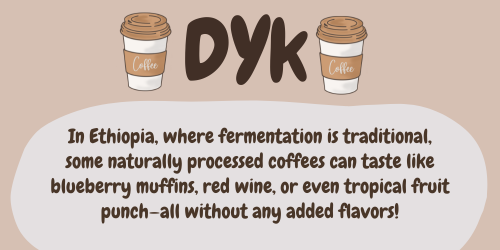
Have you ever wondered why some coffee beans have a different taste, aroma, and flavor? Why do some have a smooth, non-acidic taste, while others have a more funky flavor?
The answer is simple: coffee beans go through a variety of processes, each affecting the bean’s flavor. Generally, there are three primary coffee processes: Natural, Washed, and Honey.
In simple terms, coffee processing refers to the method of separating the coffee bean from the rest of the fruit. A coffee cherry consists of fruit, skin, pulp, and mucilage, all of which must be removed before drying the bean.

Each method differs, and while the changes may be subtle, they can have a significant impact on the flavor of the beans. Let’s take a look at these three common coffee processing methods:
In the natural coffee process, harvested cherries first go through a sorting process to remove defective (overripe or underripe) cherries. This is done by soaking the cherries in water channels, where the unripe cherries float to the surface and can be easily picked out.
In this method, the entire coffee cherry is dried under the sun on raised beds or patios while still attached to the fruit. This causes fermentation to occur, transferring sugar and flavor to the coffee bean and giving it its funky flavor.
Step 1: It’s important to note that during this process, the beans are carefully monitored and moved by hand to prevent bruising or spoiling. The beans must also be protected from rain or cooler temperatures with shelters or shades. This process can take up to four weeks.
Step 2: Once the beans are fully dried, they are stored before being hulled (removing the outer layers of the dried cherry).
Step 3: The beans are then sorted, graded, bagged, and shipped.
Results: While the natural coffee process might seem easy, it actually takes more effort and time than others. It is one of the oldest and most favored methods among coffee producers.
In the washed coffee process, after sorting, the cherries undergo de-pulping, in which the bean is separated from the fruit.
Step 1: Unlike the natural process, the beans are placed in a fermentation tank, where enzymes break down any remaining fruit residue.
Step 2: The beans are then washed to remove any residual fruit. Afterward, they are dried and carefully attended to, as the beans lack the external flavors from the fruit and only express their own characteristics. The coffee beans are dried until they reach a moisture level suitable for storage.
Results: The washed coffee process results in a clean, bright, and often acidic cup of coffee. It is now the most common process, especially for specialty grade coffees, and is highly appreciated in the market. However, the amount of water used is significant, as wet processing consumes the most water (up to 150,000 liters/day in large mills). This makes the washed coffee process a better option in regions with high rainfall and moisture.
The honey process is an intermediate method between the first two.
Step 1: In this process, the cherries are pulped to remove the outer skin while keeping the mucilage intact before drying, which can take between 7 to 21 days. Note that a higher amount of mucilage results in longer drying times, leading to more bacterial activity.
Step 2: Once dried, the parchment layer is removed. The mucilage imparts a sweet flavor to the bean, as it is rich in sugar and leaves a honey-like taste, hence the name “honey.”
Results: The honey process results in a coffee with high sweetness and low or sometimes muted acidity. More pulp means more sugar.
While often debated among coffee enthusiasts, the natural coffee process offers several advantages, from unique and rich flavors to sustainability. Here are some of its benefits:
The natural coffee process produces a variety of flavors, such as sweet, fruity, and floral notes, since the beans are not separated from the fruit but dried with it. Some are described as “funky” due to high fermentation, which results in alcohol-like notes, such as red wine.
It’s important to note that not all natural process coffee will have funky flavors. The taste depends on factors such as drying conditions and roasting.
In general, natural process coffee tends to have a heavier, fuller body, with sweet and smooth aromas.
The natural coffee process uses very little water (500–2,000 liters), mostly for cleaning, compared to wet processing, which consumes large amounts of water daily.
This method also reduces water contamination, as there is no need for fermentation tanks, making it a more sustainable option.
Farmers often choose the natural coffee process for its simplicity and affordability, as it requires little to no machinery or large water tanks, reducing electricity use.
It remains an ideal option for dry regions with low rainfall or water scarcity, such as Brazil or Ethiopia.
Beyond its practical benefits, the natural coffee process holds cultural and traditional significance. It has been used for centuries in Ethiopia and Yemen and remains a well-preserved method. Its continued use makes it an affordable and efficient option for dry climates.
With benefits come some downsides. While natural process coffee is loved for its bold, fruity flavors and sustainability, it also has some defects. Some of these include:
Fermentation is a key stage in the natural coffee process, but it can sometimes result in prolonged fermentation due to high humidity or low drying conditions. This can negatively impact the flavor of the beans, resulting in tastes similar to rotten fruit, vinegar, or spoiled milk.
High humidity and insufficient airflow can lead to mold growth on the beans, such as ochratoxin A, which can be harmful and impart musty or earthy flavors.
The long drying process makes the beans vulnerable to insect or pest attacks, which can damage the beans and introduce unwanted bitter or chemical-like flavors.
Even with careful monitoring, inconsistent drying can occur, with some beans becoming over-dried (baked) and others drying too slowly (fermented).
This can lead to a mix of underdeveloped and over-roasted (burnt) tastes.
The bold, fruity, and sometimes wild flavors of natural process coffee result from the interaction between coffee cherries, microorganisms, and the environment during the drying process.
Natural process coffee ferments inside the cherry as it dries, leading to extended contact between microbes (yeast, bacteria, fungi) that metabolize sugars and acids, creating unique flavor compounds.
Because the coffee (FYI we have compiled the list of best coffee of 2025 as well as best coffee in Brooklyn too) remains in contact with the fruit for an extended period, the pulp imparts sugar to the beans, enhancing the flavor.
An important factor is the drying process.
Coffee cherries dried on raised beds or patios have better airflow, allowing for more controlled fermentation. In contrast, low temperatures or unpredictable weather can lead to mold growth or spoilage.
Simply put, the science behind the ‘funky’ taste of natural process coffee depends on how the process is managed. When handled carefully, it can result in a finer, more desirable taste, such as fruity and exciting flavors. If mishandled, it can lead to fermented, dirty, or harsh flavors.
In short, the natural process coffee is one of the most amazing (yet risky) ways to process coffee.
Natural process coffee is highly debated among coffee lovers. Its funky taste offers a unique flavor profile for some, but it can also be undesirable for many. Here are some tips on how to adjust it to your liking:
You can enhance the funky taste of your coffee by light roasting, which maximizes fruity and floral esters. Or brew espresso to intensify the body and sweetness.
Roasting Tip: Avoid over-drying the beans, as this can cause them to lose moisture.
Medium roasts balance the funky flavor with nutty or chocolatey Maillard notes. Brewing methods such as cold brew or pour-over can clarify the fruity acidity and smooth out harsh fermented notes.
The level of funk in natural process coffee depends entirely on how it is processed, roasted, and brewed. If you are a fan of bold, funky flavors, then natural process coffee is a great option for you. However, if you prefer something cleaner, brighter, or less acidic, then honey or washed process coffee might be a better choice.
Natural process coffee often has a bold, fruity flavor profile. Since the coffee cherry dries with the fruit still on the bean, it tends to absorb more sugars and fermentation characteristics. Expect notes of berry, tropical fruit, wine-like acidity, and sometimes a heavier body.
“Funky” in coffee describes unusual, complex, or wild flavors that can come from natural or experimental processing methods. This can include fermented notes, overripe fruit, earthy tones, or even savory or yeasty elements.
Natural process coffee is typically less acidic than washed (wet-processed) coffee. It emphasizes body, sweetness, and fruity flavors more than bright acidity.
“So funky” is a casual or emphatic way to say that a coffee (or other item) has very strong, unusual, or distinctive flavors. In coffee terms, it suggests that the cup has pronounced fermented, fruity, or wild characteristics—often in a way that’s exciting or polarizing.
In order to learn more about the following topic we recommand you to check out these sources